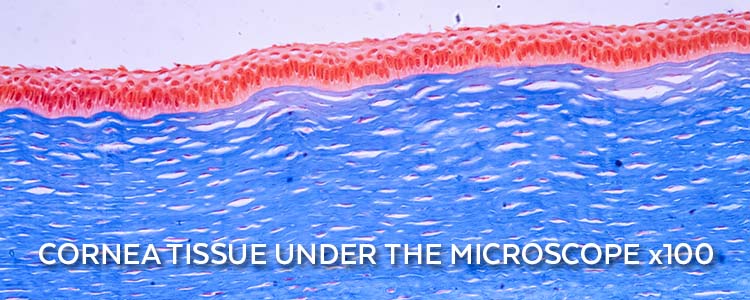Often called the “front window” of the eye, the sphere-shaped cornea is crucial to clear vision. You may not know the cornea is made of five different layers that work together to protect your eyes and help you focus on objects near and far. When the topmost layer, the epithelium, separates from the layer beneath (called the Bowman’s membrane) or any of the other layers, a condition known as corneal erosion can develop and cause pain, blurred vision or excessive watering. Because episodes of corneal erosion usually occur more than once, the problem is often referred to as recurrent corneal erosion syndrome (RCES).
What Causes Corneal Erosion?
One of the most common vision problems, corneal erosion can affect anyone and show up suddenly. If you sometimes have dry eyes and lids in the morning, you’re at risk for corneal damage. When the eye lacks proper lubrication, friction between the inner lid and the cornea can cause the epithelium to partially release from the underlying layers of tissue. Your choice of eyewear can also lead to erosion — a pair of poor-fitting or inadequately hydrated contact lenses can increase the chance of abrasion so make sure to tell your doctor if your contacts are uncomfortable.
Your medical history is another important factor in the diagnosis of RCES. Individuals who have experienced an eye injury, especially one where the cornea was scratched or punctured, are at higher risk, as are those who’ve suffered eye ulcers due to herpes. Genetic disorders or a disease like corneal dystrophy can also cause erosion of the cornea. If you are in any RCES risk group, a regular check-up with an eye care professional is necessary to keep your good vision.

Symptoms of Corneal Erosion
Corneal erosion can show up in a number of ways. A sharp or severe pain or a burning sensation in your eye might be the first sign. Ocular pain from corneal erosion can be extreme because sensitive nerves are exposed to the environment. If you don’t have pain, that doesn’t mean you don’t have RCES — many symptoms are subtle and you might attribute them to allergies or too much sunlight. Besides dryness, you might feel there’s something in your eye, become abnormally sensitive to light, or experience watery eyes. Ignoring these symptoms could lead to cell loss in the epithelium, so make an appointment at your eye care clinic to avoid the risk.
Treating Corneal Erosion
There’s nothing to fear about a check-up if you think you may have corneal erosion. During your visit, the doctor will shine light into your eyes, looking closely at the front portion where the cornea is located. The doctor might also apply a painless yellow stain to reveal any scratches or abrasions on the corneal surface. If your doctor diagnoses corneal erosion, your treatment will depend on the severity of the erosion and other factors. Most cases are treated with lubricating drops, such as artificial tears, applied before or after falling asleep at night or several times a day. Other treatment may include ointments, antibiotics, eye patches or therapeutic contact lenses that protect the cornea and help it heal.
In the most severe cases of corneal erosion, the epithelium must be surgically repaired. The eye surgeon might perform an anterior stromal puncture, a procedure in which the base of the epithelium is serrated with a needle. The small scars that result help anchor the corneal layers together, preventing more erosion. Other surgical options include corneal transplants or artificial corneas, both of which require anti-rejection drugs to prevent loss of the new cornea.
Corneal erosion doesn’t have to lead to poor vision. If you have dry eyes or any other symptoms, please contact our office to make an appointment for a comprehensive eye exam. Good eyesight depends on the cornea, so take good care of yours and enjoy a clear, bright world.
Posted February 2, 2018 by Silverstein Eye Centers